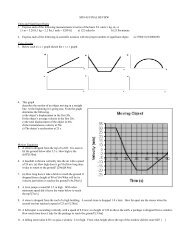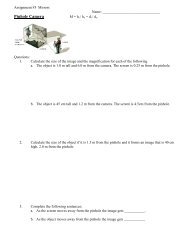APA SAMPLE PAPER.pdf - EU Libraries
APA SAMPLE PAPER.pdf - EU Libraries
APA SAMPLE PAPER.pdf - EU Libraries
- No tags were found...
Create successful ePaper yourself
Turn your PDF publications into a flip-book with our unique Google optimized e-Paper software.
<strong>APA</strong> Sample PaperRunning head: SMOKING CESSATION STRATEGIES 1Running head isleft-aligned.Page number isright-aligned.Smoking Cessation StrategiesStudent NameSchool NameCheck with yourprofessor to findout whatinformation isrequired for thetitle page.All text should be12 point TimesNew Roman font.The sole purpose of this <strong>APA</strong> sample paper is to demonstrate <strong>APA</strong> style, 6th ed.This paper was developed by the Writing Service at Conestoga College (Revised 2009).Any reproduction should acknowledge the source.
<strong>APA</strong> Sample PaperSMOKING CESSATION STRATEGIES 2Smoking Cessation StrategiesAs Canadians become more aware of the consequences of smoking and the benefitsof quitting, now more than ever before, smokers may feel public and internal pressure to quitsmoking. Although Canadians can celebrate that “smoking rates have dropped dramatically inCanada in the past three decades” (Reutter, 2001, p. 13), the remaining smokers still struggleto quit. In fact, in 2006, a Leger marketing study (as cited in Pfizer Canada Inc., 2007)Textbook,quoteSecondary source,web site,paraphraseshowed that 90% of Canadian smokers surveyed had already attempted to quit smoking . Toaid these remaining individuals and to strive for a healthier country, the healthcare community,in cooperation with the government, has invested time and money into providing smokers withinformation about smoking cessation strategies.Helpful Strategies“Smoking cessation is not a single event but a process that involves a change in [aperson’s] lifestyle, values, social circles, thinking and feeling patterns, and coping skills”Level 1 headingUse bracketsaround insertedwords.Book by corporateauthor, quote(Registered Nurses’ Association of Ontario, 2007, p. 20). However, two cessation strategieshave proven especially helpful for many smokers during this process: group therapy andnicotine replacement therapies. The effectiveness of any smoking cessation strategy will dependlargely on the individual; however, according to the Canadian Lung Association (2008),most people who quit smoking use a combination of quit methods. Research showspeople are more likely to succeed in quitting smoking if they combine severalWebsite bycorporateauthor,block quote(> 40 words)supports. For example, you can join a support group, and also have some gum orpatches on hand to overcome cravings. (para. 7)Group TherapyGroup therapy helps smokers quit by providing them with a forum where they canlisten, vent, share, and learn. Support is essential. According to Laliberte (1998), “in 21 out of39 studies, some form of professional advice or support for smokers boosted their success inLevel 2 headingMagazine fromdatabase,quote
<strong>APA</strong> Sample PaperSMOKING CESSATION STRATEGIES 3quitting by an average of 80 percent” (para. 4). Group therapy combines the professionaladvice from a counselor with support from other smokers who are trying to quit. According toRuss (2005), the facilitator and the group members are equally responsible for making thesessions worthwhile. The facilitator plays an important role in establishing a safe environmentand generating group discussion. Tsoh et al. (1997) recommend that the facilitator giveattendees information about the quitting process, teach problem solving skills and stressmanagement, and also help group members predict tempting situations and come up withcoping strategies. Table 1 shows various coping strategies that can be discussed during grouptherapy sessions.Journal fromdatabase,paraphraseJournal fromdatabase,summary,6 or moreauthorsReference totable in textTable 1Coping Strategies Discussed in Group Therapy SessionsBehavioural StrategiesCognitive StrategiesKeeping busyThinking about side effects of smokingAvoiding situations with other smokers Thinking about benefits of quittingChewing gum, eating, or drinking Being optimistic about quittingSleepingThinking about social sanctions from smokingExercisingFocusing thoughts away from smokingDeep breathingEncouraging oneself through self talkNote. Adapted from “Coping Strategies Used by Adolescents During Smoking Cessation,” byL. Jannone and K. A. O’Connell, 2007, The Journal of School Nursing, 23(3), ProQuestNursing & Allied Health Source, p. 177.Table adaptedfrom journalfrom databaseThe counselor plays an important role in this process, yet information sharingbetween group members is also vital to this process. According to “Smoking CessationInterventions and Strategies” (2008), “the functions for group therapy are to: [sic] analysemotives for group members’ behaviour, provide an opportunity for social learning, generateemotional experiences, and impart new information and teach new skills” (p. 2). When in asetting, members are asked to analyze the reasons they light a cigarette. This self-awarenessWhen there isno author, usequotationmarks aroundarticle andweb page titlesand italics forbook titles.Journal articlefrom database,no author,quote
<strong>APA</strong> Sample PaperSMOKING CESSATION STRATEGIES 4helps individuals to anticipate their triggers, prepare strategies in advance, and problem-solvetheir way through each tempting situation (see Appendix A). These support groups provideopportunities for group members to connect with others who are experiencing the sametemptations, challenges, and emotions. In response to an email survey, former smoker R.Thomson (personal communication, January 30, 2008) stated, “group members were a lifelinethroughout the quiting [sic] process.” Other survey respondents reported similar feelings (seeAppendix B). When provided with adequate support, smokers find that “although quittingsmoking may be difficult, it is not impossible” (You Can Quit Smoking, n.d., p. 1). Supportgroups can serve as a powerful tool during the quitting process as “smokers tend to quit inRefer toappendixes in thepaperPersonalcommunicationInsert [sic] afteran original error.Brochure,no author/dateNewspaper, quotegroups” (Chang, 2008, p. D3). There is little doubt that people are influenced by their peers;indeed, smokers can be encouraged to quit when supported by peers in a group setting. Just asgroup therapy has proven effective in helping smokers achieve their goals, nicotinereplacement therapy has also helped many quit smoking.Nicotine Replacement TherapyLevel 2 headingNicotine replacement therapy (NRT) provides individuals who have decided to quitwith physical support as they encounter cravings. Mosby’s Dictionary (2002) defined NRTas “the use of chewing gum and skin patches as a substitute for tobacco smoke sources toDictionary,quotesatisfy nicotine cravings” (p. 1183). Today, NRT products are not only limited to gum andpatches, but also include lozenges, inhalers, and nasal sprays. In order to benefit fully from theproduct, it is important that smokers who are trying to quit follow the directions as given onthe product packaging. For example, NRT gum needs to be chewed in a certain way in orderfor the product to work effectively to control cravings (see Figure 1).Reference tofigure in text
<strong>APA</strong> Sample PaperSMOKING CESSATION STRATEGIES 5Figure 1. How to use Nicorette gum. From Nicorette: Real medicine in the form of gum, byGlaxoSmithKline Consumer Healthcare, 2008, Retrieved June 11, 2008, from http://www.nicorette.com/Nicorette_Product.aspxWhile it is clear that companies, such as the producers of Nicorette, advertise andFigure fromweb siteInsert nopunctuationmark after aURL.promote the use of NRT products as a successful smoking cessation strategy, it is telling thatthe Ontario government and organizations such as the Centre for Addiction and Mental Health(CAMH) also promote their use. This is evidenced by the Ontario government removing PSTfrom all NRT products (CAMH, 2007a, para. 1) and by its partnering with the Centre forAddiction and Mental Health in the Smoking Treatment for Ontario Patients (STOP) programto give NRT to 13,000 smokers at no cost (CAMH, 2007b, paras. 1-2). As a result, 1,600 ofAbbreviateorganizationsafter firstmention2 web sites—same author,paraphrasesthese participants quit smoking, which pleased the Clinical Director of Addiction Programs,Dr. Peter Selby, who stated, “It’s clear there’s both a demand and a need for nicotinereplacement therapy. With the Ontario government’s help, we’re committed to find the mostWeb site,quoteeffective ways to help smokers quit” (CAMH, 2007b, paras. 4-5). Corporations, organizations,and the provincial government agree that NRT products are useful in helping Ontarianssuccessfully kick the habit.Combining two successful strategies like group therapy and nicotine replacementtherapy is the best bet for smokers who are trying to quit. Group therapy provides a personWrite numbersunder nine inwords, and10 and over indigits.
<strong>APA</strong> Sample PaperSMOKING CESSATION STRATEGIES 6with the emotional support they need, while nicotine replacement therapy gives the person’sbody relief in the form of gradually declining nicotine doses. While smoking is a toughaddiction to overcome, individuals who succeed greatly improve their chances to live longerand healthier lives; these healthy non-smoking individuals will eventually lead to a healthiernon-smoking society for all.
<strong>APA</strong> Sample PaperSMOKING CESSATION STRATEGIES 7ReferencesCanadian Lung Association. (2008). How to quit. Retrieved May 26, 2008, from httpWeb site://www.lung.ca/protect-protegez/tobacco-tabagisme/quitting-cesser/how-comment_e.phpCentre for Addiction and Mental Health. (2007a). CAMH welcomes tax break on smokingcessation aids. Retrieved May 26, 2008, from http://www.camh.net/News_ eventsWeb site, multipleentries by thesame author/News_releases_and_media_advisories_and_backgrounders/pst_eliminated_on_nrt.htmlCentre for Addiction and Mental Health. (2007b). STOP Study helps Ontario smokers “goweedless" - Nicotine replacement therapy dramatically improves quit rate.Web site, sameauthorRetrieved May 26, 2008, from http://www.camh.net/News_events/News_releases_and_media_advisories_and_backgrounders/stop_study_media_release.htmlChang, A. (2008, May 23). Quitting is contagious. Waterloo Region Record, p. D3.Laliberte, R. (1998, September). Going smokeless. Men's Health, 13(7), 106-110.Mosby’s medical nursing & allied health dictionary (6th ed.). (2002). St. Louis, MO:Mosby.Pfizer Canada Inc. (2006). How hard is it to quit smoking? Smokers agree that quittingNewspaperMagazineDictionary,6th editionWeb sitewould be one of their greatest accomplishments in life. Retrieved April 8, 2008,from http://www. pfizer .ca/english/newsroom/press%20releases/default.asp?s=1&year=2007&releaseID=230Registered Nurses’ Association of Ontario. (2007). Integrating smoking cessation into dailynursing practice (Rev. ed.). Toronto, Ontario, Canada: Author.Book, corporateauthor, revisededition
<strong>APA</strong> Sample PaperSMOKING CESSATION STRATEGIES 8Reutter, L. (2001). Health and wellness. In P. A. Potter, A. G. Perry, J. C. Ross-Kerr, &M. J. Wood (Eds.), Canadian fundamentals of nursing (2nd ed.) (pp. 2-30).Textbook,chapters bydifferent authorsToronto, Ontario, Canada: Harcourt Canada.Russ, P. (2005, May). The will and the way…. Practice Nurse, 29(9), 62-63. doi:10.2038/8830-3928.34.2.343Smoking cessation interventions and strategies. (2008, August). Best Practice InformationSheets - Joanna Briggs Institute, 12(8), 1-4. Retrieved from http://wwwJournal articlefrom databaseJournal articlefrom database,no author, no doi.joannabriggs.edu.au/pubs/best_practice.phpTsoh, J. Y., McClure, J. B., Skaar, K. L., Wetter, D. W., Cinciripini, P. M., Prokhorovet, A.V., … Gritz, E. (1997). Smoking cessation 2: Components of effective intervention.Behavioral Medicine, 23(1), 15-27. Retrieved from http://www.heldref.org/Journal articlefrom database,eight or moreauthors, no doipubs/bmed/manuscripts.htmlYou can quit smoking [Brochure]. (n.d.). Toronto, Ontario, Canada: Pharmatech.Brochure,no author/date
<strong>APA</strong> Sample PaperSMOKING CESSATION STRATEGIES 9Appendix ASmoking Triggers and Quitting StrategiesSmokers report being faced with many temptations to smoke during their journeytoward a smoke-free life. For this reason, therapy group leaders ask participants to brainstormtriggers, situations or items that make them want to smoke, and then find strategies, ways toovercome these triggers. Figure A1 is an example of common triggers and strategies a persontrying to quit smoking may use.TriggersStress Smoking paraphernalia Time of dayStrategiesGet enough sleepFind other positive outletsfor stress releaseEliminate remindersfrom your homeAvoid smokersChange daily routinesStay busyFigure A1. Example of smoking triggers and quitting strategies
<strong>APA</strong> Sample PaperSMOKING CESSATION STRATEGIES 10Appendix BSurvey Question #10 and Sample ResponsesWhen answering a short survey via email, many survey respondents went intodetail regarding how group therapy had helped them. While responses varied, the sample ofresponses below attests to the usefulness of accountability and support.Survey QuestionPlease describe the strategy that helped you quit smoking. How did it help?Answers regarding group therapyRespondent #12: “Group therapy really helped me lot. Group members were a lifelinethroughout the quiting [sic] process” (R. Thomson, personal communication, January 30,2008).Respondent #30: “Having people to hold me accountable was most important” (T. Lee,personal communication, February 3, 2008).Respondent #35: “I needed to hear other people’s stories and have their support” (B.Almutari, personal communication, February 20, 2008).Respondent #48: “My leader was great. She helped us analyze what made us want to smokeand find ways to stop. The other people in my group became my friends really quickly” (S.Medencevic, personal communication, February 21, 2008).Respondent #63: “Going to see my group helped me because I had support from peoplewho went through the same thing I did” (P. Morrison, personal communication, February22, 2008).Respondent #75: “My group really knew what I was going through and encouraged me tokeep trying to quit” (C. Haim, personal communication, February 24, 2008).
















